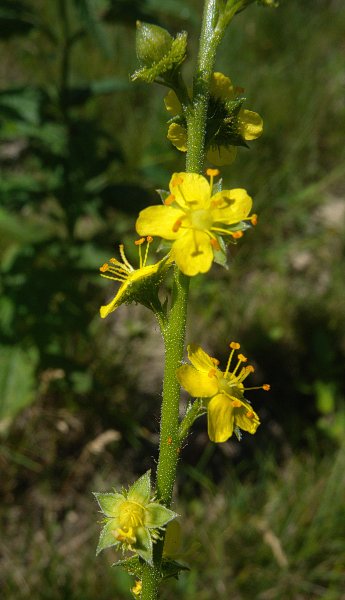
The secondary leaflets are similar to the primary leaflets, except they are smaller in size (less than ½" in length). The secondary leaflets are lanceolate to ovate in shape and their margins are either toothless (entire) or sparingly toothed. The rachises and petioles of compound leaves are light green, flat or narrowly grooved above, and convex below; they are glandular short-pubescent and sparsely to moderately covered with long spreading hairs. The primary leaflets are either sessile or they have very short petiolules (basal stalklets). At the bases of petioles, there are pairs of leafy stipules that are up to 1" long, half-ovate or ovate in shape, and sparingly toothed. The stems terminate in spike-like racemes of flowers (¾–2¼' long) that are either unbranched or sparingly so. The central stalks of these racemes are light green, terete, and glandular short-pubescent; they are moderately covered with spreading hairs below, sparsely covered with spreading hairs in the middle, and largely devoid of such spreading hairs above.
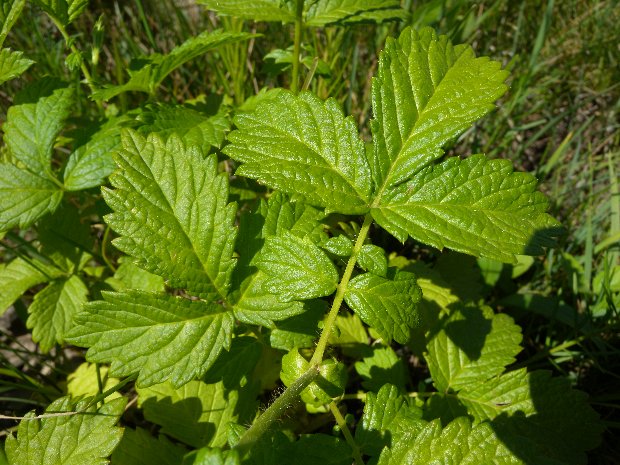
Each flower is about ¼" across or slightly more, consisting of 5 yellow petals, 5 green sepals, 10-15 stamens, and a burry hypanthium containing a pair of carpels (female reproductive organs). Both the sepals and hypanthium are minutely glandular-pubescent along their outer surfaces; the sepals are cordate-ovate in shape. The pedicels of the flowers are short (less than ¼" in length), light green, and glandular short-pubescent. The blooming period occurs during the summer for about 3 weeks; only a few flowers are in bloom at the same time. Afterwards, the flowers are replaced by burry fruits that are obconic with shallow furrows below and ovoid in shape above, tapering abruptly into an acute beak. Around the middle of each fruit, there 3-5 rows of hooked bristles that are slightly descending, widely spreading, or ascending. Mature fruits are 3½–5 mm. long and slightly wider across (including the hooked bristles); they hang downward from their pedicels. Each fruit contains a pair of seeds. The root system is fibrous and rhizomatous.
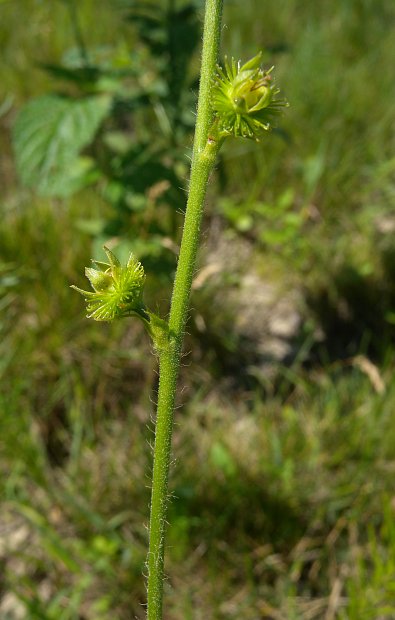
Cultivation: The preference is partial sun, moist to dry-mesic conditions, and soil containing loam or clay-loam, although other soil types are tolerated. In full sunlight, the foliage becomes yellowish green. Sometimes this plant grows in waterlogged conditions, but this is not preferred. The long spike-like racemes have a tendency to arch or lean to one side as they mature.
Range & Habitat: The native Tall Agrimony is occasional in northern Illinois, uncommon in central Illinois, and rare or absent in the southern section of the state (see Distribution Map). Habitats include upland woodlands, upland savannas, thickets, disturbed open woodlands, woodland borders, areas along woodland paths, soggy meadows, and swamps. Areas with a history of disturbance are preferred, although this species is also found in high quality natural areas.
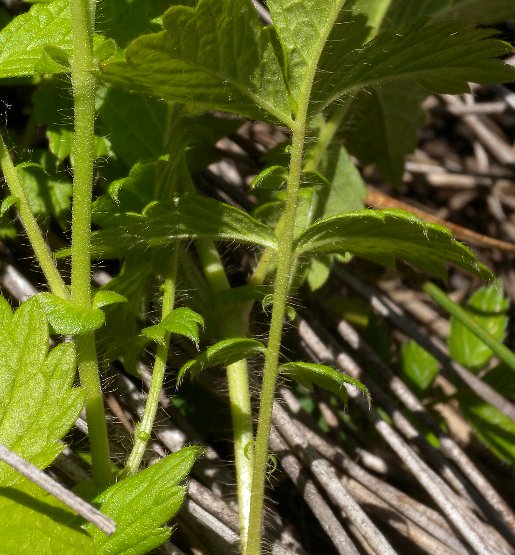
Faunal Associations: The nectar and pollen of the flowers attract primarily Halictid bees, other small bees, Syrphid flies, and other flies. Robertson (1929) observed a single species of Halictid bee, Lasioglossum versatum, visiting the flowers of an agrimony (probably Agrimonia gryposepala) in Illinois. Other insects feed on the leaves, flowering stems, and developing seeds of agrimony (Agrimonia spp.). These species include aphids (Macrosiphum agrimoniellum, Macrosiphum pallidum), larvae of a gall fly (Contarinia agrimoniae), larvae of a sawfly (Fenella nigrita), and larvae of moths (Anacampsis agrimoniella, Coptotriche agrimoniella); see Blackman & Eastop (2013), Felt (1917), Smith (2006), Covell (1984/2005), and the Microleps website (2010). The burry fruits readily attach to the feathers of birds, fur of mammals, and clothing of humans, by which means their seeds are spread to new locations.
Photographic Location: A soggy meadow at Parkland College in Champaign, Illinois.
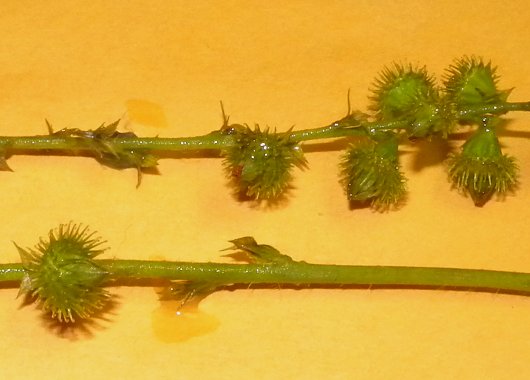
Comments: Tall Agrimony (Agrimonia gryposepala) can vary somewhat in the number of primary leaflets per compound leaf, and also in the shape of those leaflets. With the exception of Swamp Agrimony (Agrimonia parviflora), species of agrimony (Agrimonia spp.) are very similar to each other in appearance and usually prefer similar habitats. Downy Agrimony (Agrimonia pubescens) can be distinguished by the lack of glandular hairs on its flowering stalks, and similarly for Roadside Agrimony (Agrimonia striata) and Small-fruited Agrimony (Agrimonia microcarpa). While Woodland Agrimony (Agrimonia rostellata) has glandular hairs on its flowering stalks, like Tall Agrimony, it tends to have smaller fruits (typically 3-4 mm. in length) that are differently shaped and less bristly. Swamp Agrimony differs from the preceding species of agrimony by its more abundant primary leaflets (9-17 primary leaflets per compound leaf) and the more narrow shape of those leaflets. It also prefers wetter habitats than Tall Agrimony and the other species of agrimony that occur in Illinois. Another species that is not recorded from Illinois, European Agrimony (Agrimonia eupatoria), can be distinguished from native species of agrimony by the abundant long hairs on both its flowering stalks and fruits.